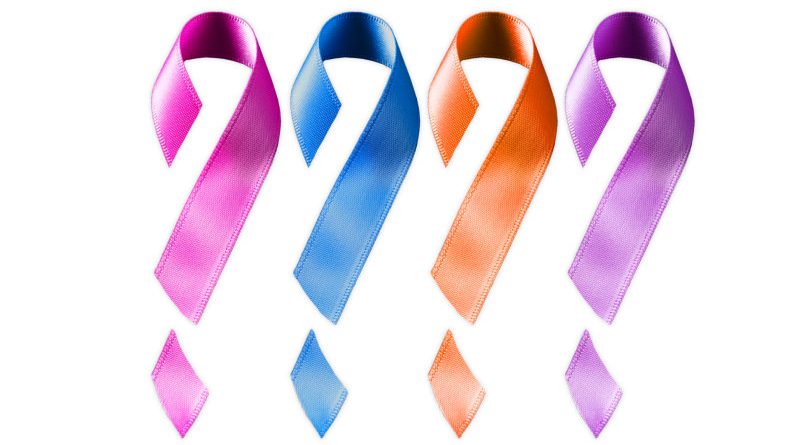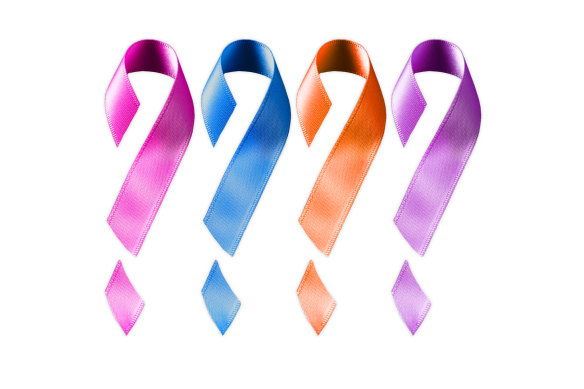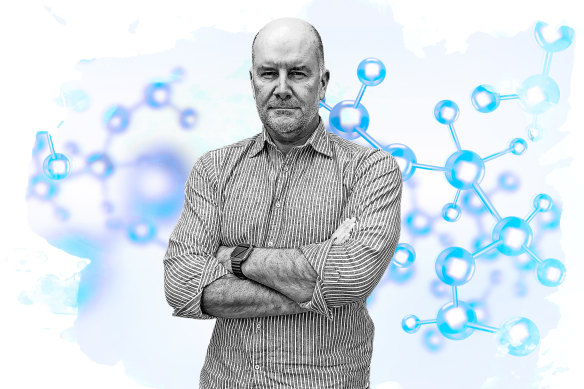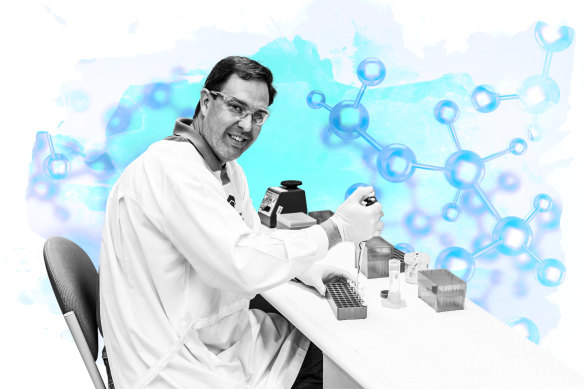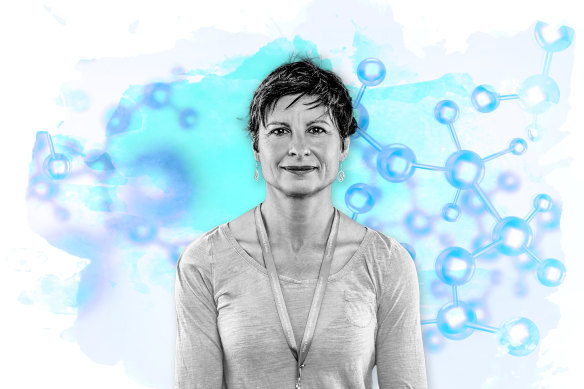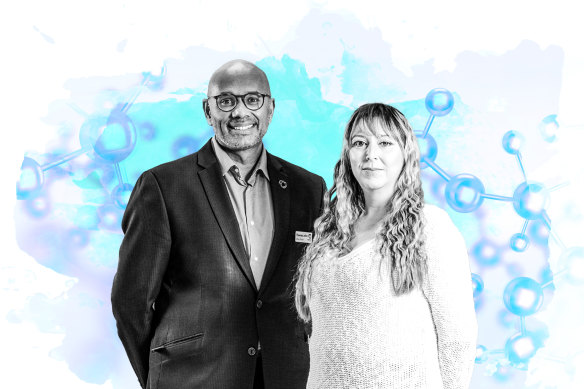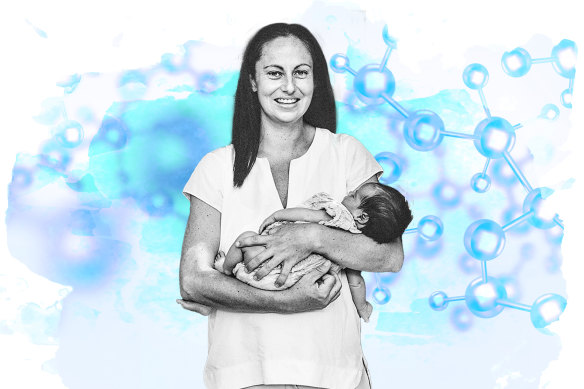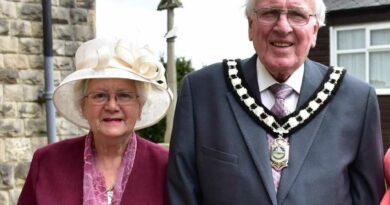Why is cancer so hard to cure?
Some 50,000 Australians die from cancer every year, even as we hear about big breakthroughs in treatments. What makes cancer so tough to tackle? And what, exactly, is it?
Credit: Richard Giliberto
Save articles for later
Add articles to your saved list and come back to them any time.
A crisis of confidence can come from the most unassuming sources. For Darren Saunders, it was a simple question from his young daughter. The cancer biologist had been feeling pretty optimistic about developments in the search for cancer cures, with “whole new classes of treatments coming through”.
“I was going around telling everybody about all these amazing things we can do and the advancements we’ve made in understanding cancer. Then my kids’ grandmother got lung cancer and I couldn’t do anything to save her,” Saunders says. “My daughter asked me: ‘Why can’t you just go to the lab and mix up some medicine to cure Nonna?’
“It was a real slap in the face. It made me contemplate for a long time what I was doing.”
Why haven’t we cured cancer? After all, we’ve been to the moon, as the cliche goes. We’ve found “cures” for other deadly diseases. As a pandemic swept the world, scientists created vaccines at breakneck speed.
Yet, despite decades of research and hundreds of billions of dollars dedicated to the search for cures, cancer is still the world’s biggest killer, responsible for the deaths of hundreds of thousands of people every year, 50,000 of them in Australia.
What is it about cancer that makes it so hard to “cure”? And where are we up to with treating it?
Darren Saunders: “I couldn’t do anything to save her.”Credit: Artwork: Monique Westermann
What is cancer?
Asked why we haven’t cured cancer, Professor Glen Boyle doesn’t hesitate: “Because it’s bloody hard!”
Rather than one disease, cancer is a constellation of more than 200. It’s been linked to mutations in between 500 and 1000 genes (of the 20,000 or so in each person). “We are literally trying to tackle hundreds of different diseases and none are easy,” says Boyle at the QIMR Berghofer Medical Research Institute in Brisbane. “Every cancer is different – so there’s our first problem. In breast cancer alone, there are 20 to 30 different cancers [differentiated by their genetic mutations]. Almost every patient has a different kind of disease that behaves differently in their individual body.”
This is where the refrain about the moon breaks down. “We know what the moon is,” says Saunders, “we know where it is, we know how far it is, what it’s made of – so it’s a fixed target. Cancer is very different in that we still don’t completely understand what it is and how it works. In terms of that metaphor, it would be like trying to fly to thousands of different moons in thousands of different places … and halfway to a moon, it might change shape or direction, or move into a different part of the sky.”
For a long time, cancers have been categorised by the organ in which they first appear (even cancer of unknown primary, which gives no clues about where in the body it started, is its own category). Today, cancer subtypes are increasingly being described by their genetic or molecular markers. In breast cancer, for example, we might talk about the mutations in the BRCA1 or BRCA2 genes. Or we might talk about HER2-positive cancer, which tests positive for a protein called human epidermal growth factors receptor 2 and tends to be more aggressive than other types of breast cancer. These markers “allow us to better define the thing we’re working against,” says Saunders, now the deputy chief scientist and engineer for NSW.
“They become really nasty and can invade and spread into other parts of the body.”
Scientists can now examine a tumour’s “fingerprint”, says Boyle, who heads the cancer drug mechanisms group at QIMR Berghofer. “We can see up to six different sorts of melanoma cells in one tumour, and they are all doing different things, mutating and growing at different rates and potentially responding differently to potential treatments.” When he started working on melanoma, the consensus was that one person’s melanoma was the same as another’s. “But when we looked at the genome, we realised, well actually, no, it’s not the case at all.”
Still, cancers do have something in common: they’re cells that have lost the normal control of their growth.
The trillions of cells in our bodies have specific functions – liver cells to break down fats and produce energy, blood cells to carry oxygen – and follow a predictable cycle of growth, division and death. “We have all of these complex control mechanisms that make our cells copy themselves only when they need to,” Saunders says.
But with cancer, one of these cells ignores the body’s inbuilt controls and multiplies uncontrollably. These haywire cells can travel through the blood or lymphatic systems, burrowing into tissue and flourishing there. “They become really nasty and can invade and spread into other parts of the body,” says Saunders, “and that is when you have very serious and often untreatable versions of the disease.”
When cancer spreads, it is called metastatic. Medicos call the original tumour “primary” and the secondary tumours “mets”, short for metastases. Pathologists speak of grades of cancer (how aggressive it is) and stages of its development (how much there is and how far it has spread). Although it is different in each case, generally a small tumour that has not spread is described as stage one, while cancer that has spread to at least one other body organ is stage four.
The deadly thing about some of the most common cancers found in parts of the body not essential for survival (say, mammary glands in the breast) is that they can infiltrate vital organs such as the lungs. “Let’s say you have a massive ball of cancerous cells growing in your lungs,” Saunders says. “That part of your lung is no longer going to be working as a lung should because those cells have lost their ability to do their jobs.”
Cancer can spread to the liver, stopping it from keeping toxins out of our system. It can cause blood to become “stickier”, heightening the risks of blood clots, including in the brain, where a stroke can occur, or in the heart. Tumours can push on parts of the brain, eventually causing a person to lose alertness and then consciousness. Infections such as pneumonia and other co-morbidities can contribute to someone’s death.
If cancer in one of his patients is yet to spread, Associate Professor Tom John will use the word “cure” when speaking with them “from the get-go because the whole intent of treatment is curative”. But for patients with metastatic cancer, John, who is deputy director of oncology at the Peter MacCallum Cancer Centre, is more circumspect, explaining to them “we’re aiming to control this, but we can’t cure it”. However, some new treatments are leading to people recovering from metastatic cancer (more on this later). If, over a long period of time, scans are continuing to show no signs of cancer, John will say: “We don’t use the c-word very often but, in this case, you may well be cured of the cancer. We don’t know this for sure. But, at this point in time, it certainly looks that way.”
Glen Boyle: “Every cancer is different – so there’s our first problem.”Credit: QIMR Berghofer Medical Research Institute. Artwork: Monique Westermann
Why can’t we just stop cancer cells spreading?
The very fact that cancer is born from our own cells – rather than from some invading foreign infection – makes it particularly tricky to treat. It’s far easier, although still an incredible feat, to produce an antiviral vaccine because the structure of a virus is materially different from that of a human cell.
“You can produce a vaccine against something like the spike protein of the coronavirus because human cells don’t have spike proteins,” says Professor Ian Olver, one of Australia’s leading cancer researchers, bioethicists and medical oncologists, “so it’ll kill the virus but won’t kill the cells around it. Cancer cells are far too much like the rest of the body’s cells, so you have got to find something on the cancer cells to target with some sort of agent that isn’t on the normal cells and so won’t harm them. Otherwise, you’ve just got something that’s toxic to both.”
Our innate immune system is pretty effective in targeting cancer cells and leaving normal cells unscathed. Says Saunders: “It’s a finely tuned, super-sensitive system that is able to recognise things that don’t look like our cells and attack and kill them off. We would have a lot more cancers than we currently do if we didn’t have functional immune systems.”
“The new emerging clones may be able to survive therapies and become resistant to them. Then we’ve got to find alternative treatments.”
The trouble is that cancers evade and suppress the immune system. Some breast cancers, for instance, communicate with their micro-environment – immune cells and blood vessels – to camouflage themselves or disarm the immune response, says Associate Professor Pilar Blancafort, program head of cancer epigenetics at the Harry Perkins Institute of Medical Research in Perth. “Triple-negative tumours can send chemical messages via small molecules called chemokines that talk to the immune cells (T cells) and deactivate them,” she says.
In this way, they can also become resistant to promising treatments. “Some aggressive tumours have so many types of mutations in their genetic material that make them primed for rapid evolution, which enables them to spread quickly to other parts of the body. The new emerging clones may be able to survive therapies and become resistant to them. Then we’ve got to find alternative treatments,” says Blancafort. “We are currently targeting the genes in the cancer cells that are responsible for these ‘talks’ with the immune system.”
Saunders calls it a perfect storm. “They are horrible little things, but this amazing, adaptive behaviour is one of the things that make them so fascinating to study.”
It’s this adaptability that means killing 99.9 per cent of the cells in a cancer tumour is no cure. Surgeons, for example, can successfully remove a tumour and follow-up treatments can “mop up” remaining cancer cells. But leaving just 0.01 per cent gives the cancer wriggle room to take off again. “Unless you kill 100 per cent of the cells,” says Boyle, “that tiny leftover remnant has already experienced that therapy agent and can adapt to basically stop itself from being killed off by another whack of that therapy.”
This is why cancer patients can feel “scanxiety” as they await results from scans after treatment. Boyle has firsthand experience. “I almost drove myself insane when my then fiancee was diagnosed with breast cancer six weeks before we were due to get married,” he says of fellow cancer researcher Sarah. “I had just started doing a little bit of breast cancer research and, knowing what I knew, I dove deep into analysing her case and prognosis.
“In the end, I had to step away and let her oncologists do what needed to be done. The good news is she’s now my wife, we have two kids and after almost eight months of chemotherapy and seven years of anti-estrogen therapy, we count ourselves very, very lucky.”
Pilar Blancafort: “Some tumours are primed for rapid evolution.”Credit: Artwork: Monique Westermann
Is it possible to target the root cause of cancers?
It sounds like a great idea, but we don’t yet completely understand their root cause. “They’ve all got different starting points,” Boyle says. “Take melanoma. We know that there is a very specific cause for the vast majority of these cancers, which is UV exposure, and we know that in about 50 per cent of these cases, the damage will be to a specific gene called BRAF [which regulates cell growth].” BRAF melanoma can be treated with targeted therapies that attack the BRAF protein to shrink and slow the growth of tumours. But in another 25 per cent of melanoma cases, the UV damage hits the NRAS gene, triggering more aggressive mutations notoriously known as “undruggable”.
“Once you’ve been dealt this bad hand, fixing the problem is like trying to unscramble an egg.”
In 2017, a study of more than 7500 tumours across 29 cancer types discovered it takes just a handful of specific mutations (between one and 10) to convert a normal cell to a cancer cell. It also found that the number of mutations driving a cancer varies depending on the cancer type. For instance, it takes about four mutations per patient on average to drive liver cancer, but colorectal cancers need roughly 10 mutations to emerge.
“Say a cancer requires five specific mutations and you have four of them. Then you’re in the clear,” explains Olver. “But your next-door neighbour is unlucky to be hit by all five mutations, and that will often trigger the cancer.” Sometimes you can inherit a couple of the mutations and a couple more will come along through exposure to your environment. The risk that mutations pose is over a lifetime, Olver adds. If you carry mutations associated with a particular cancer, “it doesn’t mean you’ll get it next week”.
The truth is that the genesis of cancer is often a horrible mix of genetics, environmental factors and bad luck in the guise of a random mutation that creeps into a person’s genes, Saunders says. “Once you’ve been dealt this bad hand, fixing the problem is like trying to unscramble an egg.”
Age is the single biggest risk factor. In 2020, there were about 294 deaths from cancer for every 100,000 Australians aged between 50 and 74. In the 75-plus age group, the number jumped to 1419. “As we age, cells have had more opportunity to divide and multiply and therefore more possibility of incorporating mutations into the genes as they divide,” says Saunders. To offer some perspective, it’s estimated that around 43 per cent of Australians will be diagnosed with cancer (not including the most common skin cancers) by the time they get to 85. A man has a 17 per cent risk of dying from cancer by this age, a woman 13 per cent, according to the Australian Institute of Health and Welfare.
Ian Olver: “The holy grail is to prevent someone getting cancer.”Credit: Artwork: Monique Westermann
Why are some cancers easier to treat than others?
There are many reasons. In general, cancers forming solid tumours are more difficult to treat than some blood cancers, such as leukaemia or lymphoma, which circulate in a patient’s system and so can be easier to reach with drugs. “There aren’t as many barriers to reaching these haematological cancers as there are in solid tumours, which can be far more difficult for treatments to penetrate,” says Olver. (Testicular cancer, which tends to respond well to chemo, is one exception.)
Given how complex tumours can be, sometimes it’s difficult to pick out which cancer cells are actually driving the disease’s progression. Tumours can also include non-cancer cells that enable cancer cells to thrive. In this sense, a tumour becomes a rogue organ with its own blood supply, nerves, lymphatic system and stroma (cells and tissues that give organs their structure). In pancreatic cancer, non-cancer cells can account for up 80 per cent of a tumour, shielding the cancer cells from the body’s immune system as well as from potential treatments.
In 2022, the Australian five-year survival rate for pancreatic cancer was 12.2 per cent.
Pancreatic cancer has one of the worst survival rates of any major cancer worldwide. In 2022, the Australian five-year survival rate for pancreatic cancer was 12.2 per cent; just 35.5 per cent of people diagnosed with it will still be alive one year after diagnosis.
Ros Pesman was one of the lucky few to survive pancreatic cancer after she was told she had it in 2010. “And it is luck,” the Australian historian and emeritus professor at the University of Sydney has previously said. “The odds were extraordinary.” Still, luck is just the name we give things we don’t yet understand, she said.
Pancreatic cancer scientists long suspected that long-term survivors like Pesman shared some unknown quality that improved their chances. In 2017, a team of researchers, including scientists at the Garvan Institute of Medical Research in Sydney, discovered Pesman’s “luck” was a quirk in her DNA. Her cancer cells produced unique protein peptides called neo-antigens that masqueraded as bacteria or viruses, enabling her immune system to identify them as something akin to an infectious disease and attack them. Pesman still had to undergo a 10-hour surgery known as the Whipple procedure to remove the cancer, which had spread to her lymph nodes, followed by eight months of chemotherapy and radiation.
Oncologist Tom John and patient Lisa Govelli, who is taking immunotherapy drugs for cancer.Credit: Chris Hopkins
What are the promising new treatments?
When doctors found a tumour on then 36-year-old Lisa Govelli’s left lung, it had grown so large it was pushing against nerves in her spine, causing her left eye to shut and triggering whole body pain after she did simple tasks such as making lunch for her two kids. Within a week, she was admitted to Peter MacCallum Cancer Centre to receive intense radiation every day except Sundays. “With radiation, they had to shrink it away from my spine straight away because they said if it did grow any more that I would probably risk paralysis,” she says.
Radiation (and surgery) aim to remove cancer from a specific area of the body. But the cancer had spread to five other places across Govelli’s torso. So she began chemotherapy – the most common cancer treatment, in which chemicals kill cancer cells (and, inevitably, some healthy cells) wherever they are. When she began to show signs of pancreatitis, doctors adjusted her chemo in case it was contributing.
The chemotherapy seemed to have almost cleared Govelli of cancer when more bad news came: another tumour was growing on her spine. “For that to happen again, I was sick in the stomach,” she says. By then, she had heard about a breakthrough in cancer treatment: immunotherapy, which turbocharges the body’s own immune system to fight cancer. Within months, it had cleared the new tumour. More than two years later, she is still taking the drug. “It would be nice to go off it, but I am nervous [that] if I went off it, something would start growing again.”
Immunotherapy is a paradigm shift from using chemicals to kill dividing cells, says Olver. “This is where we are putting our hopes for finding cancer cures.” For decades, doctors have been trying to get the immune system to fight cancer. The problem is that cancer cells have brakes known as checkpoints that stop the immune system from attacking them. Scientists made a Nobel prize-winning discovery in 2010 that the brakes could be removed on a T-cell by targeting a protein called CTLA-4. “[Immunotherapy] takes away the stop signal and allows the immune system to then recognise the cancer cell as abnormal,” says Kate Mahon, director of medical oncology at Chris O’Brien Lifehouse. Or, as Saunders puts it, “They basically wake up the immune system and say, ‘Hey, there’s a tumour over here. Come and take care of this’.”
Immunotherapies are no silver bullet, though. Even in people with the same type of cancer, the drugs might work in some but not in others. They come with their own side effects (some so severe the treatment has to be stopped) and few attract government subsidies in Australia.
In some cases, results with this drug have been remarkable. “It’s incredible. We’ve been able to discharge patients.”
One that is subsidised is the checkpoint inhibitor drug Keytruda, which targets a different protein, called PD-1. It is on the Pharmaceutical Benefits Scheme for Australians with certain types of Hodgkin’s lymphoma, melanoma and lung, bladder, colorectal, head and neck squamous cell, kidney and endometrial cancers. In some cases, results with this drug have been remarkable. In a 2021 study, a third of lung cancer patients had high expression of the PD-L1 protein, and a third of those were alive five years after receiving the drug. “It’s incredible. We’ve been able to discharge patients,” says John. “[They’re] people who came to us with stage-four disease that has spread throughout their body and would normally have been dead within 12 months.”
When Charmaine Blanch felt what she thought was ligament pain, she put it down to discomfort in the early stages of being pregnant with her daughter, Florence. Her own mother, Anne, had died of bowel cancer, aged 53, seven years earlier. “But you still don’t think you’re ever going to get it,” Blanch says. After the shock discovery she had the cancer herself, a surgeon told her she had two to three years to live. “After that surgery, I was like, ‘I don’t want to go back on the table’,” she recalls.
Her mother had undergone chemotherapy, but Blanch wanted to reduce her side effects and stay as healthy as possible. “In case I wasn’t there too long … I wanted my kids to see me at my best,” she says. Keytruda wasn’t yet on the PBS for the cancer Blanch had (which makes up 5 per cent of metastatic colon cancers) but as Florence marked her first birthday, Blanch received access to the drug at a cost of $80,000 over several years. Earlier this year, Mahon, who treated her, told Blanch she was cancer free. “You don’t get to give that level of good news very often,” Mahon says. “Fingers crossed, that’s it.”
A weight has certainly lifted for Blanch. “Cancer gives you a new meaning to life, all the little stuff doesn’t matter any more,” she says. But the difference in cancer treatments in just a few years is stark. She wonders if the outcome would have been different for her mother today. “I just wish my mum had access to immunotherapy.”
Charmaine Blanch, with baby Florence, was told she was cancer free after immunotherapy. Credit: Photo: Jerusha Sutton. Artwork: Monique Westermann
Timing is just one of the poignant aspects of cancer breakthroughs. “With every new therapy, there’s a wave of enormous enthusiasm that gets pared back over time,” says Olver. “Immunotherapy is a genuine seismic event but not the universal cure with no side effects that some people were hoping it would be.“
Another emerging area of treatment is targeted therapies, which aim to disrupt the molecules enabling a cancer to multiply by targeting specific genetic mutations or proteins. In most cases, doctors diagnose cancer by taking a sample of the tumour, which can then be used to sequence the person’s DNA. “We look for a specific number of mutations and if we find them, it enables us to use a specific therapy that targets that particular type of cancer,” says John. Targeted therapies tend not to cure people with metastatic or advanced disease but can help clear any cancer cells left after surgery and chemotherapy. In some studies, they have been shown to reduce deaths by half in people in the early stages of a particular type of lung cancer.
The hope is that one day scientists will be able to pinpoint exactly what drug will work for any given individual. “We still give drugs to people not really knowing if for that individual person that’s going to work or not,” Mahon says. “We can say in many hundreds of people this percentage is going to benefit from the drug, but you don’t know if the particular patient you’ve got in front of you is going to be them.”
Some effective cures are a long way upstream: prevention. For instance, it is entirely possible that cervical cancer could be effectively eliminated in Australia by 2035. Thanks to the HPV vaccine and cervical cancer screening, cervical cancer is one of the most preventable and successfully treatable forms of cancer globally.
Another line of defence is national screening programs for breast, cervical and bowel cancer, for example. “It’s possible to consider eradicating cancer of the bowel if we can get bowel-cancer screening rates up,” Olver says. Australians receive a bowel-screening kit in the mail every two years from age 50 until 74, but of more than 6 million people sent kits in 2020-21, only about 2.5 million returned their samples. Some 90 per cent of bowel cancer cases can be treated if caught early. “The beauty of bowel cancer,” says Olver, “is that [any] bleeding is due to the presence of a pre-cancerous polyp [that can be picked up through screening] and treated before it develops into invasive cancer.”
A diet of ample vegetables and fruit and fewer high-calorie carbohydrates, sugars and red meat, combined with regular exercise, limiting drinking alcohol, not smoking and protecting skin from sun damage can go some way too, Olver says, even if nothing can guarantee you won’t get cancer. “If universally we did all these things, we would reduce the incidence of cancer quite a bit,” he says, “and we would need to rely far less on new discoveries.”
Fascinating answers to perplexing questions delivered to your inbox every week. Sign up to get our Explainer newsletter here.
If you'd like some expert background on an issue or a news event, drop us a line at [email protected] or [email protected]. Read more explainers here.
Most Viewed in National
Source: Read Full Article
